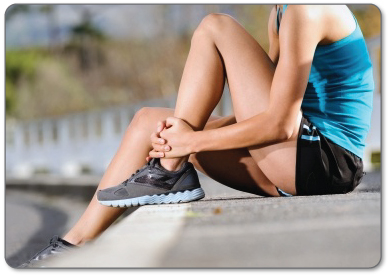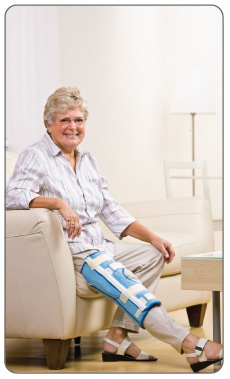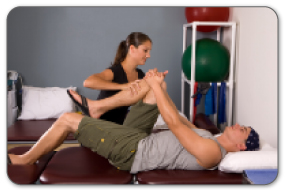If you've had surgery on your knee then your doctor will quickly get you on the path to rehabilitation. The aggressiveness of your rehabilitation efforts and your injury's ability to heal will depend on a variety of factors including (but not limited to):
Know that no 2 rehabilitation plans are alike - The less invasive your surgery is, the quicker your road to recovery will be.
The goal of a rehabilitation plan is to manage pain and swelling while improving function, strength, and range of motion. Ultimately at the end of your recovery you'll regain strength and return to full activity. In order to achieve this you'll most likely spend a lot of time with a physical therapist after your surgery, but as your healing progresses, emphasis will be placed on your conservative treatments at home.

The success of your rehabilitation will depend on your dedication to working with your physical therapist while also managing your recovery on a daily basis at home.
No matter what type of surgery you've had (or even if you don't need surgery at all) you home therapy routine can be improved by controlling initial and on-going pain/swelling, increasing blood flow to heal your knee injury, and incorporating daily stretches to increase range of motion so that you can achieve long-term, positive results.
All of this can easily be done by incorporating the use of a Knee TShellz Wrap® and utilizing specific stretches (from your physical therapist or doctor) into your rehabilitation routine. Regular treatment using a TShellz Wrap is intended to help decrease time spent in recovery.

During the first 24 to 72 hours after surgery your knee will be tender, swollen and very painful. Your knee may be weak and unstable, and depending on your surgery, you may have to weara knee brace or use crutches for a few weeks. One of the things to keep in mind when recovering from knee surgery is the importance of resting in the beginning, but getting active and going through rehabilitation when it's needed. When you're recovering from surgery and using tools to keep weight off of your knee (like a knee brace or crutches) then your knee and the surrounding muscles aren't as active as they once were.
If you fail to deal with proper rehabilitation of your knee after surgery, muscles loss (atrophy) will occur in your leg. The soft tissue and cartilage in your knee joint may start to wear away (a process called degeneration). There is always a possibility of re-injuring your knee even after a surgical procedure has been done.
Ask any doctor and they'll tell you that the success of your surgery depends on your level of dedication to regular at home care of your knee. Most of our knee post-op clients have treated themselves succesfully through regular use of cold compression and the Knee TShellz Wrap®.
Using these therapies will lessen the chance and/or severity of knee joint degeneration and surrounding muscular atrophy during your rehabilitation process. In some cases our customers have prevented the onset of degeneration through regular use of these treatments. They will even combine these therapeutic treatmetns with the rehabilitation plan recommended by their doctor, surgeon or physical therapist.
Use of an Ice pack and a Knee TShellz Wrap will go a long way towards a healthy recovery following surgery.
After the incision site has healed (if there is one) and swelling has reduced, speak with your doctor about using our Knee TShellz Wrap® for stimulating increased blood flow in the treatment area. TShellz Wrap®treatments are also intended to help maximize flexibility of soft tissue and help minimize scar tissue growth that will form in your knee as you heal. Minimizing scar tissue growth is arguably the most important step following surgery, especially in a joint such as the knee where its flexibility is essential.
Leaving the scar tissue untreated can lead to stiffness, chronic pain, osteoarthritis or other chronic conditions. You're more likely to end up with another knee injury if you choose not to treat the scar tissue that develops in your knee. Circulatory Boost encourages more oxygen and nutrients to flow to the area to speed healing and improve the strength of the soft tissue in your joint.
As you maintain healthy blood flow circulation in your knee it's also important to keep moving. If you stop moving your joint will stiffen up and surrounding muscle and soft tissue will begin to atrophy (waste away). Once the swelling is down, try to maintain a routine of gentle passive stretching after a treatment with the Knee TShellz Wrap®.
Ok, so enough about the products, lets take a close look at the stages of recovery...
Rehabilitation and PT after an arthroscopic or open knee surgery will first focus on protecting your knee and initiating simple movement.
Directly after your surgery has been completed, your knee will go through Step 1 of the healing process by stopping the bleeding that has started because of the incisions and work done inside of your knee. Depending on the type of procedure you have just had, your tissue may be sutured together, reconstructed or removed to fix your underlying condition. In any case, as with any injury to your tissue, the tissue in your knee will be bleeding again. Depending on the type of injury you have, your surgeon may even stimulate bleeding during your surgery to trigger the healing process.
Typically your body will have begun to stop the bleeding as soon as your surgeon has completed your surgery. This means that the veins carrying your blood will close off, and your blood will coagulate (condense to seal the bleeding off) in order to reduce the amount of blood loss in your body. Your body knows to do this automatically because blood is so vital to the healing process. Blood is basically the vehicle for oxygen and nutrients that travel directly to the injury in your knee - where these things are needed most.

If you have undergone an arthroscopic surgery, you may have less blood loss and your doctor or surgeon will check before you leave to make sure your bleeding at the incisions has stopped. If you have undergone an open knee surgery, your doctor and/or surgeon will check your incisions periodically over the next few days of your hospital-stay to ensure that your body has stopped the bleeding on its own and also make sure that your incisions are starting to heal.
After your incisions and repaired/removed tissue has stopped bleeding; your knee will become tender, swollen, red and hot to the touch - these are all symptoms of inflammation. Step 2 of the healing process is inflammation reduction. At this point you will be home if you have had arthroscopic surgery, or you may still be in the hospital if you have had open knee surgery. In order to reduce pain, swelling and inflammation your doctor will prescribe an anti-inflammatory drug to be taken during the first week or 2 after your surgery. Your surgeon will also recommend a treatment for dealing with inflammation, like R.C.C.E. (Rest, Cold, Compression, Elevation). You can use a Cold Compress or Ice Pack often (as prescribed), several times a day, to control your inflammation and reduce your pain.
Rest at this point is vital to your rehabilitation plan depending on the surgery you have undergone. If you have had arthroscopic surgery with minimal work from your surgeon, you may be encouraged to start movement early or as soon as possible. Walking with the aid of crutches and a knee brace will be required in most cases after the surgery. If you have had an invasive open surgery, then you may be encouraged to rest longer at first before starting movement with you knee brace and crutches.
Your doctor or surgeon will advance you to the next Phase of rehabilitation when there is no evidence of inflammation or swelling in your knee. If you have had arthroscopic surgery, your doctor may expect that you are able to walk around pain free (with the aid of crutches or a knee brace if needed) before moving onto the next Phase of rehabilitation.
After the initial healing of your knee injury (when Step 1 and 2 of the healing process is done), temporary tissue will start to grow to replace any veins, nerves and tissue that were damaged during your injury or the surgery. Step 3 is the Growth of Temporary Tissue.
Temporary tissue will pull together the two sides of your tissue tear, and strengthen any area where you will have sutures. This tissue will lay the foundation for stronger, healthier tissue to come, but it will be soft and not as strong as regular healthy tissue. This is why you really need to be on "re-injury watch" and make the most of your home therapies for the rest of your rehabilitation. You want to avoid over-doing it at any point during the next few weeks or months of rehabilitation will as consequences could send you right back into the operating room.
Once your new tissue has begun to grow you will be encouraged to gain back some of your range of motion (ROM) and increase the stability of your knee. Your doctor or surgeon may also introduce regular PT appointments. You may still be expected to wear your knee brace to reduce the amount of stress you are placing on your knee during movement.
You will start gradual movement of your knee in a free (non-forced) way with very low impact exercises. Your knee may be stiff at first, and you should expect simple and easy movement to be a bit more difficult for you to master and painful. Exercise of any kind is a method of increasing blood-flow in your knee to increase the amount of oxygen and nutrients that travel to your injured tissue.
You can increase your blood flow before exercise to warm up your tissue and increase your ease of movement. Apply a Knee TShellz Wrap treatment for approximately 15 to 20 minutes (finishing 15 minutes before exercise) to warm up your knee and increase elasticity of your tendons, ligaments and muscles. The increased elasticity will help minimize tissue tears and scar tissue growth.
Some of the basic exercises you will start with may include controlled flexing (bending) of your knee by sliding your heel away from your body then back toward your body. Other exercise and strengthening may focus on the use of a stationary bicycle, or stretching of the leg muscles surrounding your knee (quadriceps, hamstrings, thighs and calves) to increase the overall stability of your knee joint.
Controlling post-exercise swelling and inflammation is crucial during this Phase. Any sign of swelling or inflammation after exercise may be an indication of minor re-injury to your knee or to the surrounding tissues and muscles. Control inflammation immediately after exercise with an ice pack or cold compress.
If you are not careful to treat your swelling or inflammation immediately after exercise you will experience a set-back in your recovery.
Your doctor, surgeon or physical therapist will advance you to the next Phase of rehabilitation when you show measured improvement of range of motion (ROM), strength, stability and flexibility of your knee. The level of improvement will depend on the severity of your injury and the type of surgery you have had. For example, if you have had a relatively simple arthroscopic repair of tissue, you may be expected to walk normally (no limping) before moving to Phase 3 of your rehabilitation.
After temporary tissue has grown (Step 3 of the healing process), this temporary tissue will go through different stages of conversion into healthy, normal, flexible tissue. This is Step 4 of the healing process (Complete Tissue Re-Growth). Before converting into healthy tissue, temporary tissue will often become tough, dense, fibrous scar tissue. Scar tissue has a weak and unorganized tissue structure, which makes it brittle. Scar tissue will provide your injury with more long term fusing together, but will also stick to surrounding healthy tissue in your knee. The growth of this scar tissue is what stiffens your knee, restricting movement and flexibility.
This Phase of your rehabilitation will focus on an increase in activity level in order to regain full range of motion (ROM) and muscle strength in your leg. Continued exercise and activity will break up and soften scar tissue. Your doctor of physical therapist will increase your activity by introducing regular use of a stationary bicycle (or other cardiovascular exercise), and additional stretching exercises (lunges, hamstring curls, quadriceps stretching and movement of your hip and lower leg). Continued exercises and stretching will minimize the growth of scar tissue and also increase the elasticity and strength of your knee joint. After using stretching exercises (from your physician or physical therapist), your knee joint will be better prepared to handle higher and higher loads.
You will probably be able to stop using your crutches at this point as long as you focus on walking slowly and normally. Limping during rehabilitation should be avoided at all costs, because abnormal walking could result in re-injury of your knee, or even injury to your opposite leg, feet, hip or your back. If you have been limping to speed up your recovery, you will probably start to notice compensation pain in your opposite leg, hip or back. You can easily treat compensation pain with your doctor of physical therapist during your regular appointments, and can even further reduce this pain at home with a Knee TShellz Wrap. A Knee TShellz® Circulatory Boost Wrap will relax your muscles, effectively getting rid of stiffness and aching caused by compensation pain.
Continued use of cooling therapy (R.C.C.E.) after exercise and activity may still be recommended by your doctor. Like we mentioned before, controlling your pain and inflammation will go a long way to reduce your risk of re-injury. If you are noticing any recurring inflammation, you can continue R.C.C.E. treatments with a cold compress 2 to 3 times per day as recommended by your doctor.
Your doctor or physical therapist will advance you to the next Phase of rehabilitation when they feel that you have regained full ROM (range of motion) without pain in your knee. You may also have to pass clinical exams or tests of your muscle strength, balance, stability and flexibility in order to be cleared for Phase 4.
When your overall condition and range of motion has improved your doctor or physical therapist may clear you for a return to work or athletic activity. In many cases, they may recommend that you continue muscle strengthening and stretching instructed during your rehabilitation in order to maintain healthy ROM of your knee. Additional cardiovascular exercise will also be encouraged. If you are an athlete or have a job that requires extensive physical capability, your doctor or physical therapist will likely advise a very gradual return to previous activity.
Scar tissue may plague you for weeks, months and maybe even years after your surgery depending on your level of activity and the amount of conservative therapy you have undergone during your rehabilitation. Scar tissue will be a major problem, especially when it comes to re-injury of your knee.
Even if you have been cleared to get back to activity, you still must be careful with the activity you take on. You need to keep in mind that your knee won't be back to 100% for some time (if at all) - so continued stretching with the exercises and stretches (outlined in the ebooks), treatment with a Knee TShellz Wrap® and the use of a Cold Compress or Ice Pack (when you experience inflammation) will maintain good health of the knee and significantly reduce your risk of re-injury.
Living with pain is never easy as it affects your entire lifestyle. Living with pain during or after an intensive surgery and lengthy rehabilitation period can be even harder! Nothing is more important than making the proper decision when it comes to treating your knee pain after your surgery. Rehabilitation at-home while attending regular PT or doctor appointments is vital for your overall recovery. Consistent exercise and conservative treatment on a daily basis during your rehabilitation while working with your doctor, surgeon or physical therapist is key!
MendMyKnee stands out in this regard as our goal is to help you heal for the longer-term during your post-operative rehabilitation and beyond.
The bottom line is, you are welcome to try our products for a 60 day period after your surgery, during your rehabilitation. Discuss our products with your doctor or physical therapist, and ask your medical professionals if integrating these therapies into your daily life is right for you! If you do not receive the benefits that countless of our other customers have experienced, simply return your purchase back to us and we will issue a prompt & full refund. There will be no hassle and no hard feelings.

Click HERE to Go To Our Online Store We take all major credit cards and Paypal. If you are on your mobile phone, Click to Call Our Office (toll free continental NA).
Product Advisors are available 9:00 am to 5:00 pm Eastern Standard Time Monday to Friday.
Learn more about Knee Surgery and Post-Surgery Recovery
Learn more about how the TShellz Wrap® stimulates blood flow.
Learn more about Ice vs Heat Treatments for Knee Strain
During your recovery, you will probably have to modify and/or eliminate any activities that cause pain or discomfort at the location of your soft tissue injury until the pain and inflammation settle. The more diligent you are with your treatment and rehabilitation, the faster you will see successful results!
Please be aware that this information is neither intended nor implied to be a substitute for professional medical advice. CALL YOUR HEALTHCARE PROVIDER IMMEDIATELY IF YOU THINK YOU MAY HAVE A MEDICAL EMERGENCY. Always seek the advice of your physician or other qualified health provider before using any of our outstanding products to make sure they are right for you and your condition or if you have any questions regarding a medical condition. Always see your doctor for a proper diagnosis as there are often many injuries and conditions (some very serious) that could be the cause of your pain.
© 2025 In.Genu Design Group, Inc. Contact Us